Metrolinx has a really good plan to extend Line 4 across Toronto, but we can make that plan even better!
Metrolinx, I promise if you build all of this, I will never ask you for anything ever again...probably.
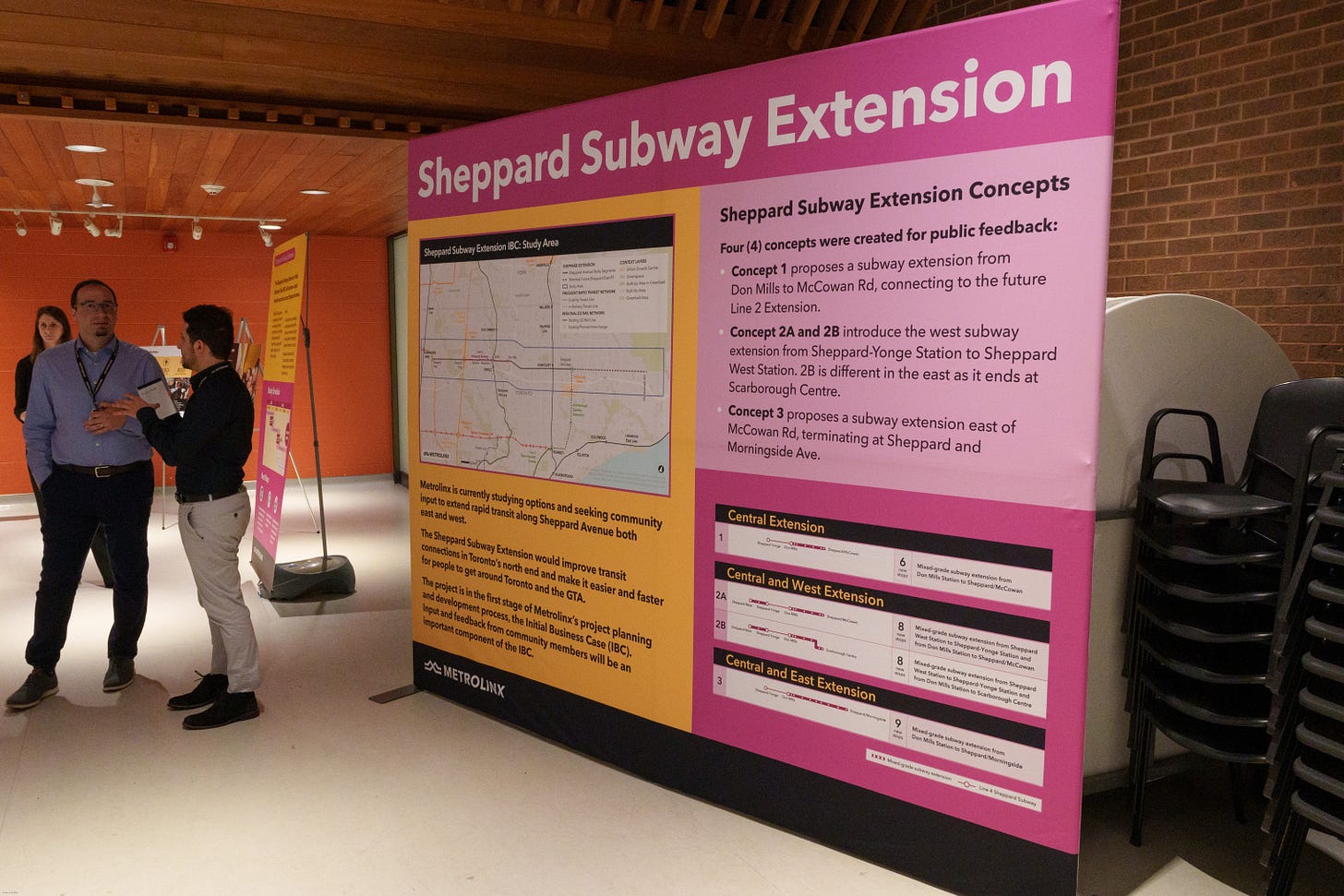
Quite literally since before the opening of Line 4 in the fall of 2002, it was always planned for the Sheppard metro line to extend across the two legs of Line 1, to Sheppard West Station. When Sheppard West Station first opened in 1996, then known by the name of Downsview Station, it already had protections in the design to allow for easier construction of that Line 4 platform.
While the plans for westward extension were shuttered by the election of Mike Harris as Premier in 1995, it was due to Mel Lastman’s influence that Line 4 was salvaged into it’s current form, unlike the Eglinton West metro project which was cancelled entirely. Line 4 has been derisively referred to as Toronto’s “stubway”, or a white elephant project, but in my opinion it has always held far greater potential than it was given credit for.
Finally, after decades of countless musing by various politicians to either extend Line 4, or to add a separate tram route extending eastward from the Don Mills Station terminus, Metrolinx is finally putting forth a solid proposal to properly extend Line 4, the way that it was originally intended. This Metrolinx plan already has my enthusiastic support, but there are a few critiques I would like to offer, that I believe will make this Line 4 extension as optimal and efficient as it could be for both the government and the public.
Go west, young traveler!
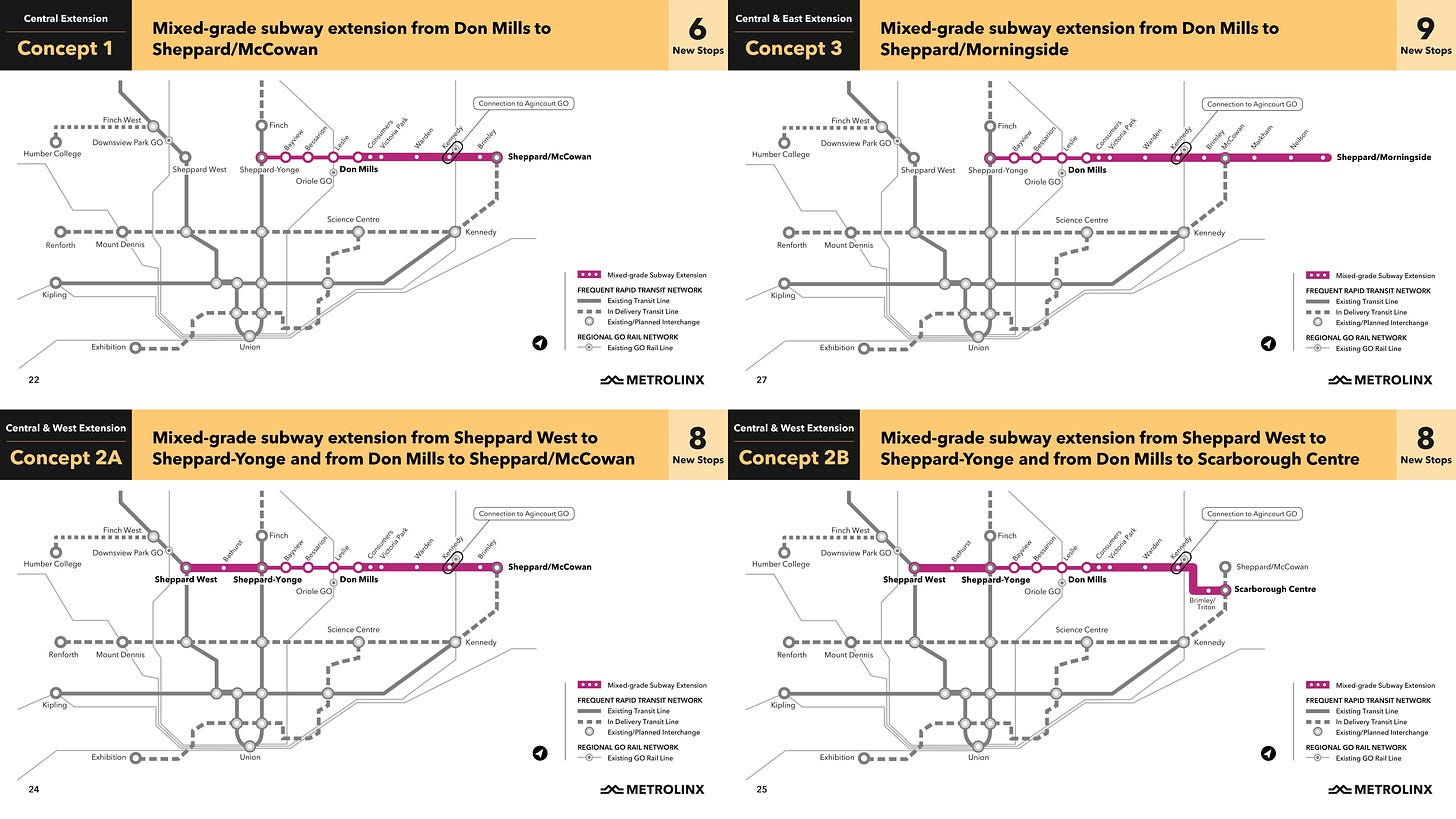
Metrolinx has proposed four different options for routing of the Line 4 expansion, based on what they believe can be delivered together as a single phase. Pictured above, these are the four concepts that Metrolinx is soliciting feedback for:
Concept 1: Line 4 would be extended eastward from the current terminal of Don Mills Station, to connect with the new Sheppard/McCowan Station opening with the Line 2 Scarborough extension in 2030
Concept 2A: In addition to an eastward extension from Don Mills Station to Sheppard/McCowan Station, Line 4 would be extended westward from the current terminal at Sheppard-Yonge Station to Sheppard West Station, linking both sides of Line 1.
Concept 2B: While Line 4 would have the same westward extension from Sheppard-Yonge Station to Sheppard West Station, the eastward extension to meet Line 2 would instead terminate at Scarborough Centre Station rather than Sheppard/McCowan Station as in the previous two concepts.
Concept 3: Abandoning any proposal of a westward expansion as in Concept 2A or 2B, Concept 3 would follow the same eastward route as Concept 1 from Don Mills Station to meet Sheppard/McCowan Station on Line 2’s extension. However, rather than terminating at McCowan Road, Line 4 would continue further eastward to terminate at a new Station located at the intersection of Sheppard Avenue and Morningside Avenue.
From the outset, I would immediately disregard Concept 1 or Concept 3 on the basis that the western expansion to Sheppard West Station must not be considered optional in any Line 4 expansion project. The ability to take Line 4 westward would relieve a significant amount of crowding on the crush-loaded eastern half of Line 1, allowing transit riders to instead travel into and out of the downtown core on the relatively less strained western half of Line 1.
Not only will this optimize the system for ridership, westward expansion would also allow Line 4 to use the TTC’s largest rail yard, Wilson Yard, for storing and maintaining their trainsets. Currently, Line 4 stores their trains at the smaller Davisville Yard, which requires the trains to transfer from Line 4 onto Line 1 at Sheppard-Yonge before they can move into the yard at Davisville Station. This would also allow Line 1 and Line 4 to diverge further in the technology and trains they run, if it suits the transit operator to do so.
Some arguments have been made that a Line 4 extension west of Sheppard-Yonge would not be necessary if Line 6 Finch West was instead extended eastward to link the two halves of Line 1. This is misguided in my opinion, as Line 6 is a light rail surface tram, and Line 4 is a heavy rail metro; they are two different modalities and they serve a complementary purpose to each other.
The distance from Finch West Station to Finch Station is much longer than the distance between Sheppard West Station and Sheppard-Yonge Station. In addition, as a surface tram stopping for traffic lights at intersections, Line 6 will travel at a slower speed than a grade-separated metro, and also have stations spaced much tighter together that will prevent acceleration to top speed.
While Finch would absolutely benefit from an eastward extension of Line 6, that project should come in addition to Line 4’s westward extension, and not as a replacement for it. The same way that the Line 2 metro on Bloor-Danforth and the 512 St. Clair tram complement each other in the middle of Toronto, the Line 6 tram and the Line 4 metro will complement each other in North York. And if you believe it’s silly that the 512 St. Clair tram is numbered as a streetcar, and the Line 6 Finch West tram is numbered as a rapid transit service, don’t worry; I think it’s incredibly silly too.
In any case, Line 6 should add full transit signal priority to improve the business case for extending the tram line to Finch Station. Upgrades and expansion for the Line 6 tram do not conflict with improvements and expansion for Line 4 metro, and they’ll likely serve different riders attempting to reach different destinations.
Back on the topic of Line 4’s western extension, my sole large disappointment with Metrolinx was that neither Concept 2A or Concept 2B include further westward expansion of Line 4 past Sheppard West Station towards the new Downsview Park Station, built during the extension of Line 1 into Vaughan in 2017.
And then, go west a bit further still.
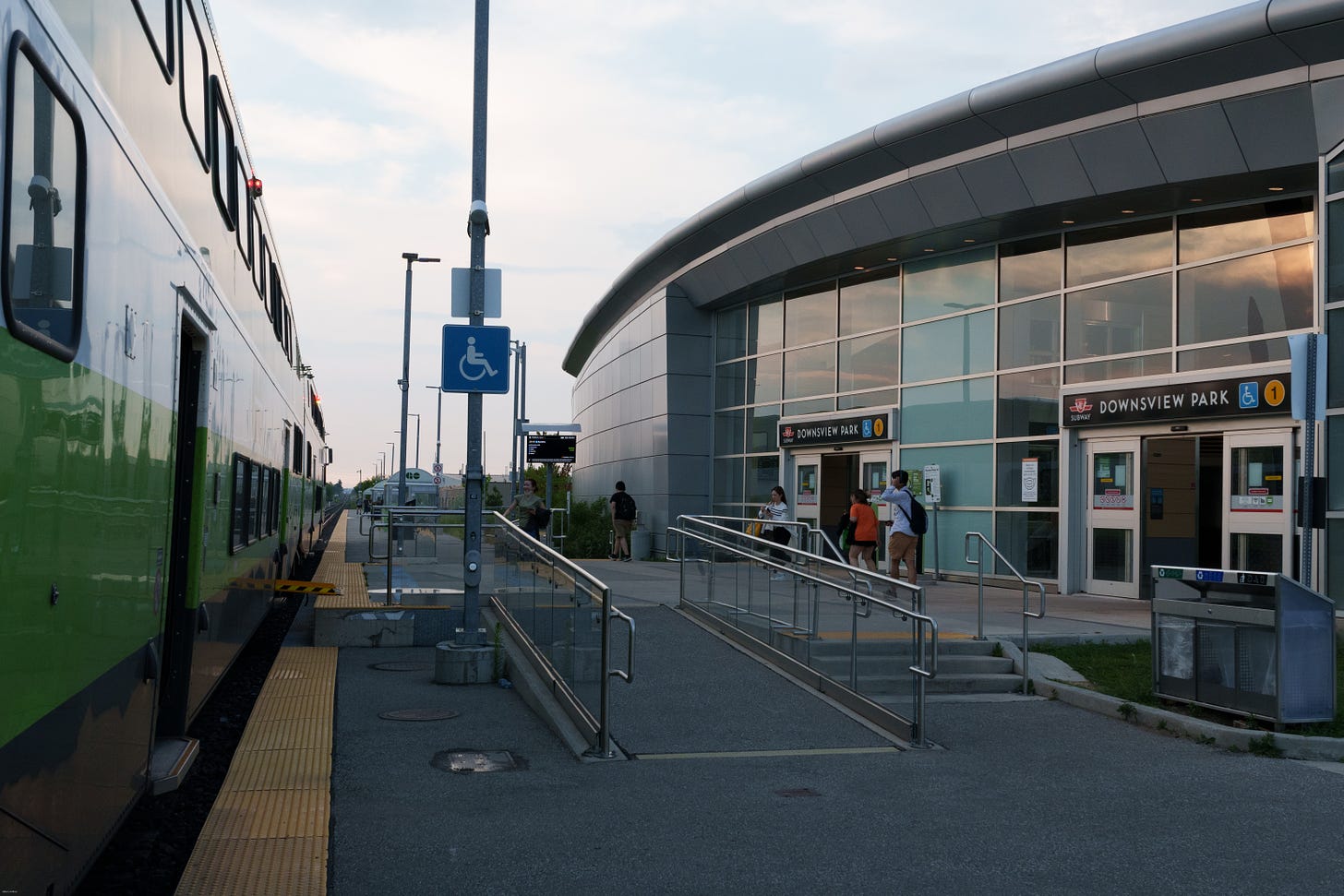
Downsview Park Station, opened in 2017 with the Toronto-York Spadina Subway Extension, is notable for being directly connected to the GO Train’s Barrie Line. While current service on the line has limitations, Metrolinx is well into double-tracking the Barrie Line, which they boast will enable all-day 15-minute frequency in both directions.
The benefit of extending Line 4 further from Sheppard West Station to Downsview Park Station is that riders will be able to transfer directly to the Barrie Line without needing to take a second transfer onto Line 1 for an inconvenient single-stop journey. It greatly increases the efficiency of how Line 1, Line 4, and the Barrie Line are used by transit riders at interchange stations, and enables new kinds of routes and journeys that previously were not feasible on public transit in the GTHA.
For example, those living along the western portion of Line 4 could transfer onto the Barrie Line at Downsview Park Station, instead of using the slower Line 1. These regional trains make fewer stops and thus can travel between stations much faster; riders can transfer at Caledonia Station to Line 5 when it opens, continue downward to transfer at Bloor-Lansdowne Station to Line 2, or ride to the end of the line at Union Station and connect onwards to VIA intercity rail, GO regional transit, or various TTC services.
Riders already benefit a great degree from the fare integration between GO and the TTC; by integrating GO regional trains and TTC metros and trams into a tighter network, we can create a far more effective system for transit riders to use, akin to Paris where all these modes of rail transit are organized to a greater degree of harmony than Metrolinx has currently accomplished.
To the benefit of the planners at Metrolinx, they informed me in our discussions that any western extension to Sheppard West would have protections in the design to make it economical to extend the line further to Downsview Park in another phase. I respect that they are already aware of the benefits this kind of interchange station would provide, and that they are attempting to plan for it’s inclusion…eventually.
However, the longer such an extension is delayed, and the further the site at Downsview Park is developed for residential and commercial use, the higher the costs of extending Line 4 to Downsview Park Station will inflate over time. There is little merit in delaying something that Metrolinx themselves already recognizes large benefit in eventually building, and it will be hard to build the political pressure to fund that second phase if it can’t be bundled into the main project.
The people of Scarborough yearn for Line 4.
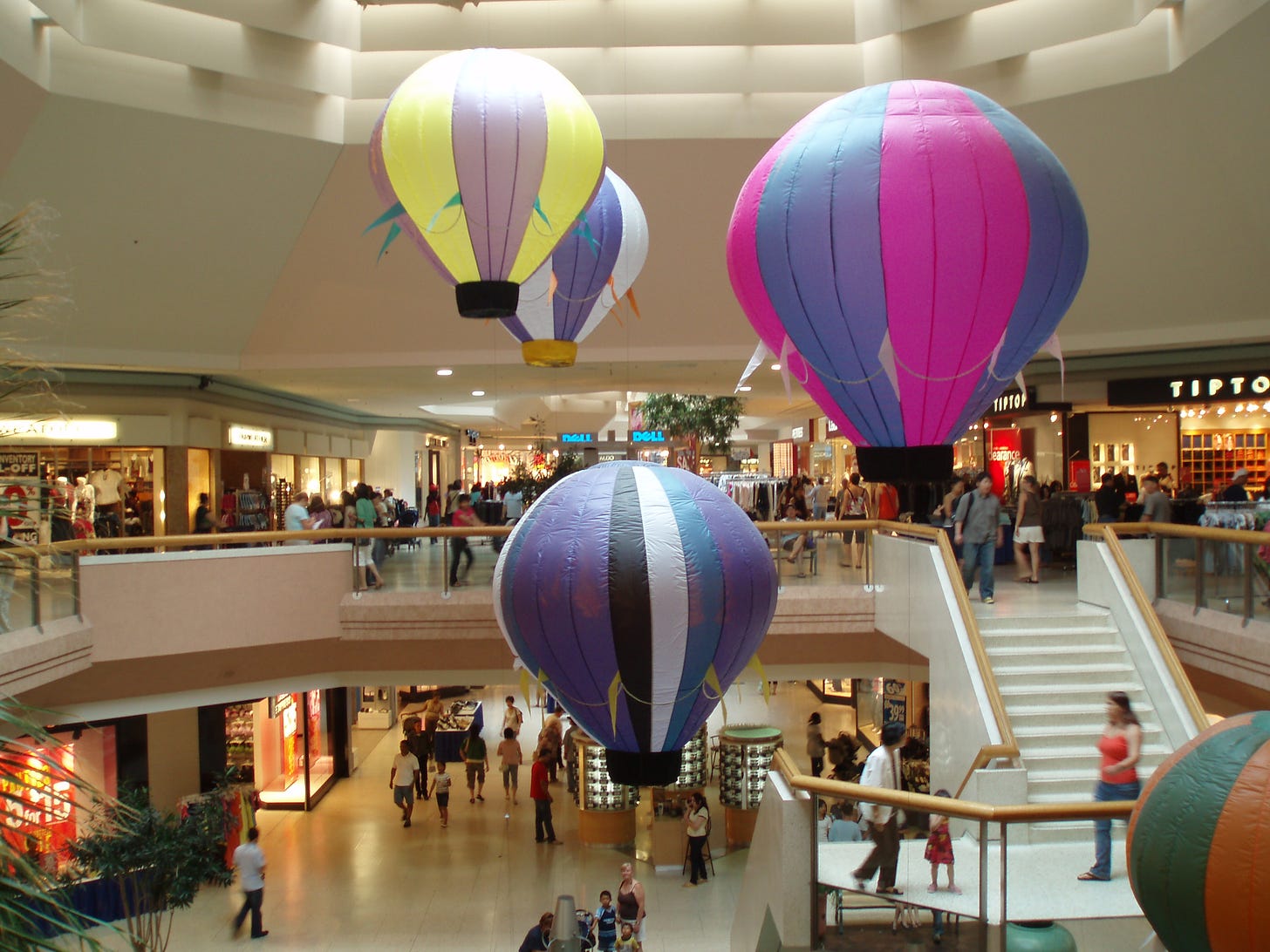
Between Concept 2A and 2B, I lean decisively in favour of terminating Line 4 at Scarborough Centre Station rather than Sheppard/McCowan Station. While instinctively it may seem logical to follow roads in straight lines, terminating at Scarborough Centre Station will actually result in far more efficient journeys for most travelers. This is by virtue of the greater density which already exists at Scarborough City Centre, combined with a significantly popular shopping mall and the civic centre where many municipal services are offered.
It makes sense to put the eastbound terminal Line 4 station and Line 2 interchange at Scarborough Centre Station rather than Sheppard/McCowan Station, largely in the interest of preventing unnecessary transfers, similarly to the philosophy behind extending Line 4 further west to Downsview Park Station to reach the GO Train.
Since far more transit riders will either begin or end their journey at Scarborough Centre Station rather than Sheppard/McCowan Station, terminating at the former will prevent many riders from needing to transfer onto Line 2 for a single-ride stop, while terminating at the latter would force unnecessary transfers and clog up transit infrastructure.
Terminating at Scarborough Centre Station would additionally give a cleaner path for a future eastern extension of Line 4 towards Centennial College, and then terminating at the University of Toronto Scarborough campus, something that would be of obvious benefit to countless students and faculty over the decades to come. Following Sheppard Avenue to McCowan Road would place Line 4 a further distance from those important hotspots where transit riders actually are.
Lastly, the TTC currently operates the seasonal bus route 200 Toronto Zoo, which links Rouge Hill GO Station on the Lakeshore East Line to the titular Toronto Zoo; if a Line 4 station was built at Ellesmere Road and Morningside Ave, the TTC 200 bus route could instead operate directly from that station more efficiently than it does from the Rouge Hill GO bus loop.
The existing Line 4 needs improvement, too.
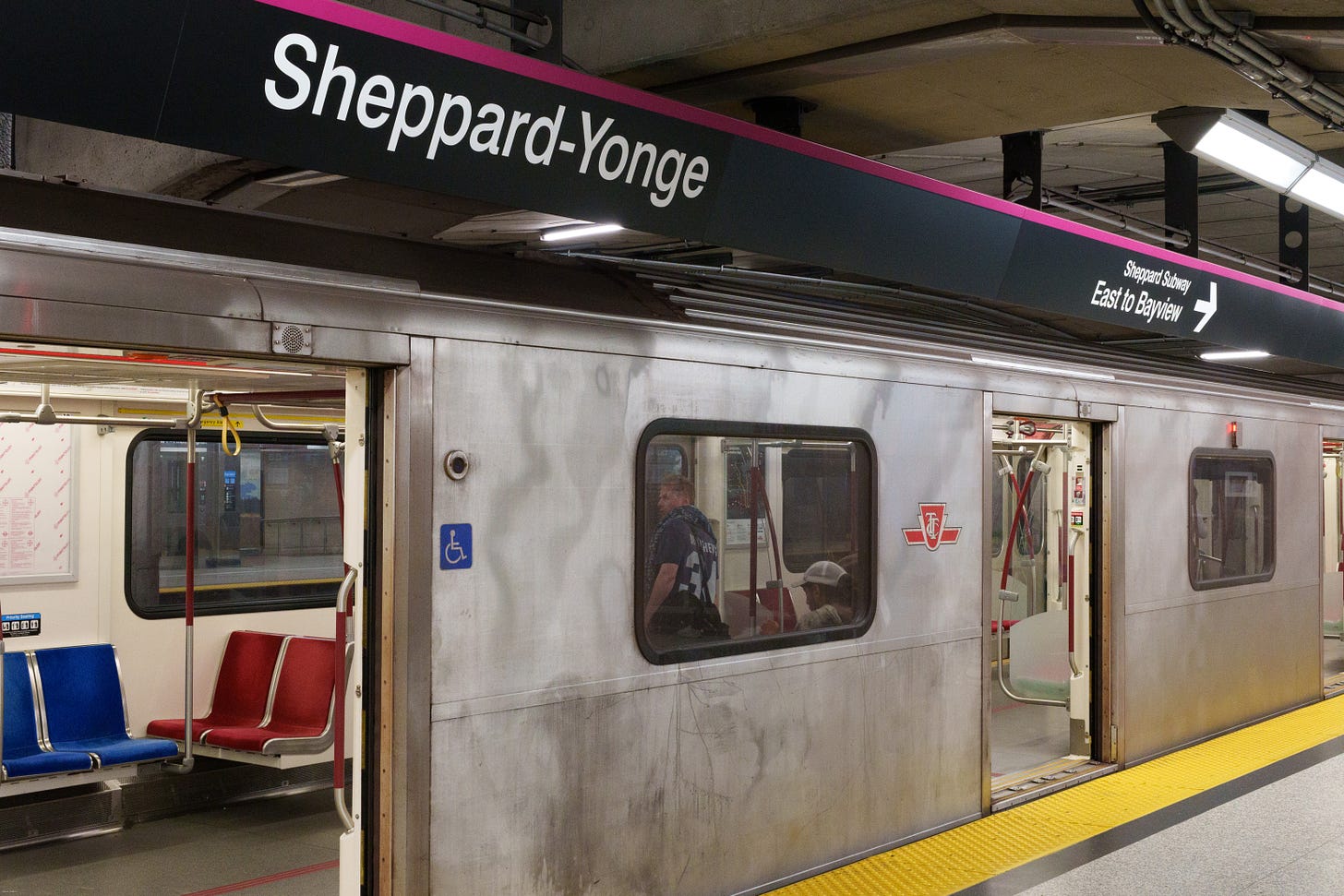
Regardless of whatever extensions are added onto the existing Line 4, there are significant improvements and considerations for the metro line as it exists today.
While Leslie Station on Line 4 is located in the general area of Oriole GO Station, and Metrolinx advertises this as a transfer point to the GO Train’s Richmond Hill Line, the truth is that this transfer point is extremely painful. The walk between the Line 4 and GO platforms is fully outdoors and roughly a kilometre in length, ranging from inconvenient in the summer to outright hazardous in the winter.
The expensive solution would be an enclosed tunnel from the current GO platform to the Line 4 station, which would likely require the same kind of moving sidewalks formerly used in the shorter tunnel at Spadina Station for transfers between TTC Line 1 and Line 2. Such moving sidewalks are no longer used at Spadina Station, but are still used in the underground pedestrian tunnel at Billy Bishop Airport, and scattered across Pearson International Airport in Mississauga.
The far more pragmatic solution, however, would instead simply use available land along the Richmond Hill Line that is physically closer to Leslie Station, and then relocate the GO train platform north to that more convenient location. The new journeys enabled through a robust and efficient transfer between Line 4 and the Richmond Hill Line, will provide similar benefits and relief to Line 1 as my proposed connection between Line 4 and the Barrie Line at Downsview Park Station.
Don Mills Station, the current eastern terminal of Line 4, is located at the popular Fairview Mall; in addition to the eastern expansion proposals included in all four of the Metrolinx concepts, there is work that needs to be done at the station regardless of Line 4 expansion, in preparation for future expansion of the Ontario Line.
Metrolinx was already smart to replace Toronto’s Relief Line plan with the Ontario Line, as the Relief Line would have terminated at Line 2, while Ontario Line will pass through Pape Station on Line 2 and instead is currently intended to terminate it’s northern end at Science Centre Station on Eglinton’s Line 5.
As a result, the TTC’s 25 Don Mills local bus, and 925 Don Mills Express bus will both have a large segment of their route replaced by metro service on the Ontario Line service between Pape Station and Science Centre Station. To fully provide relief on the Yonge Street segment of Line 1, the natural second phase of the Ontario Line would extend the metro line further north of Eglinton, following the route of the 25 and 925 TTC bus routes directly into Don Mills Station on Line 4.
By extending Line 4 both westward and eastward, enhancing the existing connections with GO Train services, and constructing new connections where they currently don’t exist, Metrolinx will be able to evenly distribute transit riders across a variety of different rail lines in and out of Toronto’s downtown core. In addition, this will enable a wide variety of new journeys on an orbital route, allowing riders to avoid going through Toronto’s congested downtown core if it is not the destination of their travels.
Finally, while Line 4 has benefitted from the labour efficiencies of One-Person Train Operation since 2016, it still only uses inefficient fixed block signaling; with an upgrade to communications-based train control (CBTC) and ATC like Line 1 completed in 2022, Line 4 could benefit from improved safety, improved frequency, and lower maintenance cost from more efficient acceleration and breaking.
When these extensions of Line 4 are constructed and open, it’s important that they’re built from the start with the most advanced signaling and automation that we know can be retrofitted into the five existing Line 4 stations. Knowing from the start which signaling technology we want to upgrade to means we can build that initially in the expansion.
If we plan now, we only have to retrofit five stations, but if we delay on adding CBTC until after the expansion is complete, we will spend exponentially more money refitting over a dozen stations, and Ontario can’t afford that kind of cost inflation for an upgrade we all know will eventually be required. The biggest obstacle in the path of any provincial government on transit planning, is successfully avoiding the allure of becoming penny wise and pound foolish in Ontario’s austerity-friendly political culture.
In conclusion, I’m very happy.
As I told CityNews while present at the consultation, I’m very happy with the proposal that Metrolinx has put forward. While I’ve put forward a large quantity of constructive criticism, I greatly appreciate the length and detail in which Metrolinx planners took notes during their conversations with me at the event, and I have confidence that the people working on the Line 4 project are both extremely passionate about their work, and extremely well-educated on transit planning.
My criticisms of the TTC are much harsher in contrast, because the TTC does not make an earnest effort to listen to feedback, let alone act on it. Metrolinx has worked extensively over the past year to rapidly take the feedback of both transit enthusiasts and casual riders, improve services based on that feedback, and then rather than move on, they will take additional feedback on the change and then tweak their improvements even further to add polish.
I hope that Metrolinx takes most of my feedback into consideration with the expansion of Line 4, including building off Concept 2B. I definitely couldn’t include every single aspect of criticism I wanted to mention in this piece, but I hope I highlighted the most important bits, and I’m sure fellow transit enthusiasts will be happy to tell me what I missed. Metrolinx is doing great work on this initial proposal, and I’m excited to see their work on this project moving along at a steady clip.
Ultimately however, beyond Line 4 or any other single project Metrolinx is undertaking, the stark contrast I have witnessed between Metrolinx and the TTC has convinced me of one thing: I now fully support uploading the TTC into Metrolinx, where it can be fully merged and integrated with GO as a single transit agency.
Ontario is in a better position than individual municipalities to cohesively plan and fund transit for the wider GTHA, and Metrolinx is clearly far more responsive to the needs of transit riders than either the TTC’s bureaucratic or political leadership. The TTC is incapable of rising above the petty political considerations of Toronto’s municipal politics and austerity budgets, while Metrolinx has proven their ability to maintain progress through the shift between Liberal and Conservative governments.
I am thrilled about the active work that Metrolinx is doing on GO Expansion, on the Ontario Line, and soon on Line 4 as well. It is a relieving change of pace for me, now that I finally feel optimism about the future of public transit in Toronto. I hope that Metrolinx continues to keep up the good work on these projects, and hopefully some of that good momentum can rub off on Line 5 and get it over the finish line.



